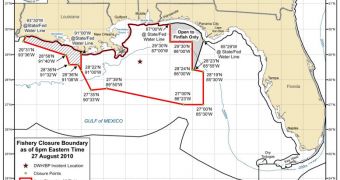Officials at the US National Oceanic and Atmospheric Administration (NOAA) announced yesterday that they will be reopening 4,281 square miles of Gulf waters off western Louisiana to commercial and recreational fishing.
The decision was agreed upon by researchers at NOAA and the Food and Drug Administration (FDA), and by representatives of Gulf states. No oil was seen in the area since July 18, experts explain.
“Scientists, food safety experts, members of the fishing industry and local, state, federal officials, are working together every day to ensure that seafood from the Gulf is safe to eat,” explains Jane Lubchenco, PhD.
She is also the US undersecretary of commerce for oceans and atmosphere, and the Administrator of NOAA. “We will remain vigilant and continue to monitor and test seafood in reopened waters,” she adds.
According to official measurements, only a light oil sheen was observed in the area over the past month, more precisely on July 29. Since then, no further signs of contamination appeared.
“Because of our strict adherence to the reopening protocol agreed to by the states and the federal government we have confidence that seafood harvested from this area is free from harmful oil residues and can be enjoyed by consumers around the nation,” adds FDA Commissioner Margaret Hamburg, MD.
The area to be reopened is located about 185 miles west of the Deepwater/BP wellhead, which ruptured on April 20 following a violent explosion. It contains mostly reef fish, menhaden and shrimp.
“Sensory analyses of 41 samples and chemical analyses of 125 specimens that were composited into 14 samples followed the methodology and procedures in the re-opening protocol, with sensory analysis finding no detectable oil or dispersant odors or flavors, and results of chemical analysis well below the levels of concern,” NOAA officials add in a press release.
At this point, data from the Administration show that only 48,114 square miles remain entirely sealed for commercial and recreational fishing. The area is equivalent to 20 percent of the federally-controlled waters in the Gulf.
As investigations unfurl, NOAA will continue to assess and reassess which fisheries and areas it will keep closed over the coming months.
As soon as test analyses show that a region of the Gulf is safe for fishing, experts will reopen that particular surface.
Oil decomposition is taking place faster than expected, and this may reduce the long waiting times ahead, experts add.

 14 DAY TRIAL //
14 DAY TRIAL //